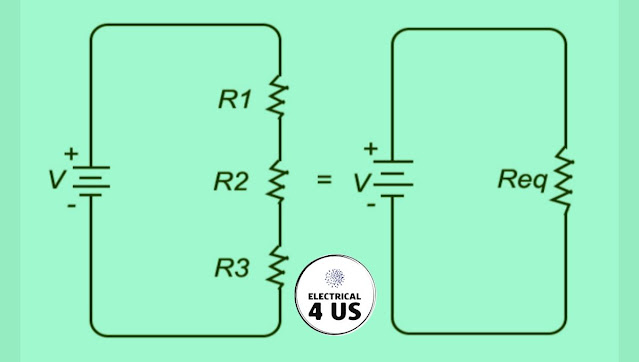Calculator
- Home
- Transformers
- _What is Transformers?
- _Top 10 Transformers In India
- Electrical genrating Plants
- _Hydro Power Plant
- _Biomass Power Plant
- _CHP Plant
- _Fossil Fuel Plant
- _Thermal Power Plant
- _Solar Power Plant
- Generator
- _Top 10 generator
- _Genrator Price
- _DC Generator
- Invention & Laws
- _Light Bulb Invention
- _Faraday's Law of Induction
- _Faraday's Law of Electrolysis
- _Fleming Right hand rule
- _Joule's Law of Heating
- _Ohm's Law of Conduter
- _Lenz's Law of electromagnet
What determines is resistor connections are in series or parallel? Resistor in Series and parallel formula | Calculator class 10
Series and Parallel Resistor
Most circuits have more than one resistor. If several resistors are connected together and connected to the battery, the current supplied by the battery depends on the equivalent resistance of the circuit.
Series Resistor
Resistors are said to be in series whenever current flows through the resistors sequentially. Consider Figure below, which shows three resistors in series with an applied voltage equal to V(Ab). Since there is only one path for the flow of charges, the current through each resistor is the same.
Req = R1 + R2 + R3 + ...+Rn
leq = l1= l2 l3 = in
leq = l1 + l2 +l3 + ... + In
Veq = V1 + V2 +V3+....+vn
One consequence of components connected in a series circuit is that if something happens to one component, it affects all other components. For example, if several lamps are connected in series and one bulb burns out, all the other lamps go dark.
Req= 1/ R1 +1/R2+ 1/R3 = V
Parallel Resistor
Resistor are in parallel when one of ends of all the resistors are connected by a continuous wire of negligible resistance and the other end of all the resistors is also connected to each other through a continuous wire of negligible resistance. The potential drop across each resistor is the same.
The current through each resistor can be found using Ohm's law I = V/R, where the voltage is constant across each resistor. Normalizing to any number of N resistors, the equivalent resistance R(eq) of a parallel connection is related to the individual resistances by tra.
Req = 1 / R1 + 1 / R2 + 1 / R3 + .. + 1 /Rn
Leq = l1 + l2 +l3 + ... +in
Veq = V1 = V2 = V3 = Vn
An equivalent resistance has R(eq) which is less than the smallest of the individual resistors. When resistors are connected in parallel, more current flows through the source than either of them flows separately.
Most Popular
Categories
- 10 kVA Stabilizer (1)
- Alternator (3)
- Ampear (1)
- Armature (1)
- Battery (1)
- Biogas (1)
- Biomass (1)
- Boiler (1)
- Bulb Thomas Alva Edison (1)
- Capacitors (1)
- Cogeneration (2)
- Conductor (1)
- Contractor (1)
- Crankshaft (1)
- DC Generator (1)
- Diesel Generator (2)
- Diodes (1)
- Earthing (1)
- Electric Meter (1)
- ElectricIan Tools (1)
- Electricity generation (1)
- Electricity Saving Tips (1)
- Electrolysis (1)
- Electromotive force (1)
- Electron (1)
- EMF (1)
- Faraday's law (2)
- Fleming rules (1)
- Fossil Fuel (1)
- Fuse (1)
- Generator (2)
- Heater (1)
- Hydropower (1)
- Ic (1)
- Incandescent Bulb's Law (1)
- Inverter (1)
- Joule's Law of Heating (1)
- Kirchoff current law (1)
- Kirchoff Voltage Law (1)
- Kirloskar Generator (1)
- Lenz law (1)
- Lighting Arrester (1)
- Magnetic Field (1)
- MCB (2)
- Motor (1)
- Multimeter AC and DC Measuring tools (1)
- Nuclear Power plant (1)
- Ohm's Law (1)
- Power Factor (1)
- RCB (1)
- RCBO (1)
- RCCB (1)
- Rectifier (1)
- Relay (1)
- Resistor (1)
- Resistor in series Resistor in parallel Resistor formula Resistor calculator Resistor problem (1)
- Servo Stabilizer (1)
- Short circuit Circuit breaker (1)
- Solar Energy (1)
- Star delta (1)
- Thermal Power (1)
- Tidal waves Power (1)
- TOP 10 Cable (1)
- Transformer (2)
- Turbine (1)
- Windmill (1)
Popular Post
Labels
- 10 kVA Stabilizer
- Alternator
- Ampear
- Armature
- Battery
- Biogas
- Biomass
- Boiler
- Bulb Thomas Alva Edison
- Capacitors
- Cogeneration
- Conductor
- Contractor
- Crankshaft
- DC Generator
- Diesel Generator
- Diodes
- Earthing
- Electric Meter
- ElectricIan Tools
- Electricity generation
- Electricity Saving Tips
- Electrolysis
- Electromotive force
- Electron
- EMF
- Faraday's law
- Fleming rules
- Fossil Fuel
- Fuse
- Generator
- Heater
- Hydropower
- Ic
- Incandescent Bulb's Law
- Inverter
- Joule's Law of Heating
- Kirchoff current law
- Kirchoff Voltage Law
- Kirloskar Generator
- Lenz law
- Lighting Arrester
- Magnetic Field
- MCB
- Motor
- Multimeter AC and DC Measuring tools
- Nuclear Power plant
- Ohm's Law
- Power Factor
- RCB
- RCBO
- RCCB
- Rectifier
- Relay
- Resistor
- Resistor in series Resistor in parallel Resistor formula Resistor calculator Resistor problem
- Servo Stabilizer
- Short circuit Circuit breaker
- Solar Energy
- Star delta
- Thermal Power
- Tidal waves Power
- TOP 10 Cable
- Transformer
- Turbine
- Windmill






0 Comments